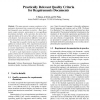Free Online Productivity Tools
i2Speak
i2Symbol
i2OCR
iTex2Img
iWeb2Print
iWeb2Shot
i2Type
iPdf2Split
iPdf2Merge
i2Bopomofo
i2Arabic
i2Style
i2Image
i2PDF
iLatex2Rtf
Sci2ools
SERP
2008
2008
Practically Relevant Quality Criteria for Requirements Documents
Abstract. This paper presents common weaknesses of requirements documents from commercial software projects that frequently cause problems in practice. Many documents contain extensive, unstructured or even superfluous descriptions of details. At the same time, they lack a thorough description of the aim of the software system or one of its features. Such documents are difficult to read and to work with and they unnecessarily restrict possible solutions. We argue that two quality criteria must be considered in addition to common criteria. First, requirements documents should be based on a sound refinement of the main goals to concrete requirements. Secondly, they should follow the principle of minimality, i.e., no more details than necessary. In order to gain improvements in projects in practice, quality criteria must be communicated to authors. For this purpose, we propose two visualizations, which describe the information structure of the document in a technology-free and domain-inde...
| Added | 30 Oct 2010 |
| Updated | 30 Oct 2010 |
| Type | Conference |
| Year | 2008 |
| Where | SERP |
| Authors | Tobias Simon, Jonathan Streit, Markus Pizka |
Comments (0)

